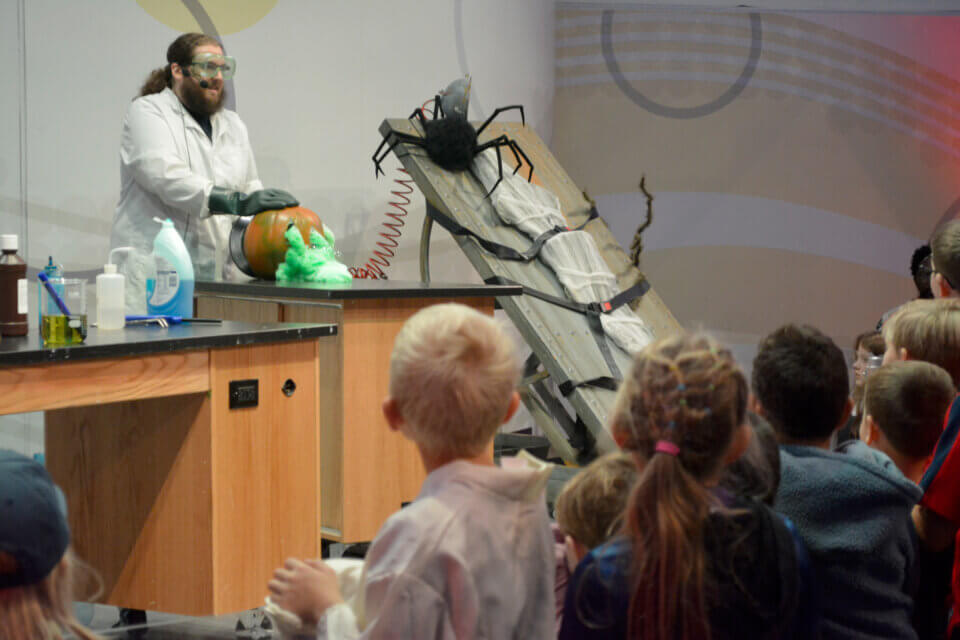This is the Saint Louis Science Center’s NIGHT SKY UPDATE for the week of Friday, December 2, 2022. Information updated weekly or as needed. Times given as local St. Louis time which is Central Standard Time (CST). For definitions of terminology used in the night sky update, click the highlighted text. If relying on times… Continue reading
Astronomy Fact of the Day: December 3, 2022
December 3, 2022 Of the eight planets in our solar system, we can see five without the help of a telescope – Mercury, Venus, Mars, Jupiter, and Saturn. Tonight after sunset, it is possible to see Mars, Jupiter, and Saturn. Mars will be found in the east and Jupiter and Saturn can both be found… Continue reading
Astronomy Fact of the Day: December 2, 2022
December 2, 2022 On this date in 1990, Toyohiro Akiyama became the first person from Japan to fly in space, the first civilian aboard a commercially funded spaceflight, and the first journalist to report from space. Akiyama was a TV journalist with the Tokyo Broadcasting System (TBS) at the time. It was TBS that sponsored… Continue reading
Astronomy Fact of the Day: December 1, 2022
December 1, 2022 On this date in 2013, China launched the robotic lunar exploration lander Chang’e 3, with China’s first lunar rover, Yutu-hao (‘jade rabbit’). Rover Yutu explored its landing area in Mare Imbrium and sent back pictures of the surface of the Moon for several weeks. An image of the Chang’e lander taken by… Continue reading
St. Louis Supports STEAM for Giving Tuesday
Support science for our future. Make a gift to the Science Center’s Annual Fund to help support the Science Center’s education programs. Thank you to everyone who supported the mission of the Saint Louis Science Center and STEAM (science, technology, engineering, the arts, and math) education this Giving Tuesday! Support from our philanthropic partners helps… Continue reading
Astronomy Fact of the Day: November 30, 2022
November 30, 2022 Astronomical conjunctions occur when two or more celestial bodies share the same right ascension. Tomorrow night at 6:56 pm, the Moon and Jupiter will exhibit a conjunction. At the same time, the two will appear close together in the sky. At their closest, the Moon will pass approximately 2.5° S of Jupiter.… Continue reading
At Science Spooktacular, the YES Program’s Media Arts Teens Develop STEAM Skills One Picture at a Time
Support science for our future. Make a gift to the Science Center’s YES Program to help support the Science Center’s education programs. Featured photo by YES Teen Harmony Cooper Guests at the Science Center on the weekend of October 29 and 30 got to experience science thrills and fun at the Science Center’s annual Halloween-themed… Continue reading
Astronomy Fact of the Day: November 29, 2022
November 29, 2022 The Earth is on average 93 million miles from the Sun. This distance is often referred to as an astronomical unit (AU). By measuring distances in AUs, it allows scientists to understand the large scale of our solar system more easily. For example, Pluto is approximately 39 AU from the Sun. This… Continue reading
Astronomy Fact of the Day: November 28, 2022
November 28, 2022 Beginning around sunset this evening at 4:41 pm, it is possible to find the Moon very near Saturn in the southern sky. The Moon will exhibit a waxing crescent phase. At their closest Saturn will appear 4° N of the Moon; however, this will not occur until after they have set below… Continue reading
Astronomy Fact of the Day: November 27, 2022
November 27, 2022 On this date in 2005, the Japanese probe Hayabusa grazed the surface of the asteroid Itokawa, retrieving material to return to Earth for study. Tiny grains of asteroidal material were returned to Earth aboard the spacecraft in June of 2010. An artist’s interpretation of the Hayabusa probe interacting with the surface of… Continue reading








